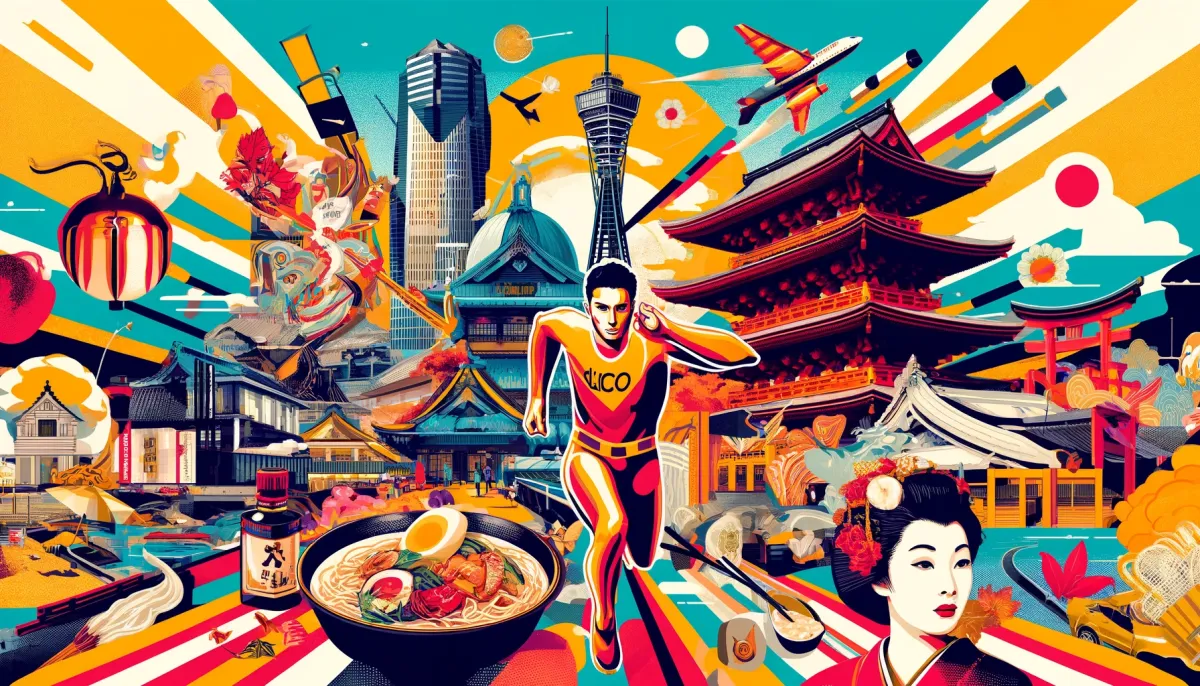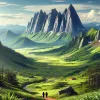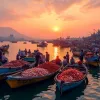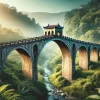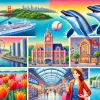Hey there, fellow adventurers! It's Mark, your friendly neighborhood backpacker, back from another epic Asian escapade. This time, I traded in the European charm of Austria and Czechia for the vibrant energy of Japan, spending six unforgettable days exploring the wonders of Osaka and Kyoto before hopping on the Shinkansen to Nagoya for my flight home. Ready to dive into my top 10 must-do experiences? Let's go!
Osaka: A Metropolis of Delights
Osaka, Japan's third-largest city, pulsates with a unique blend of modern marvels and traditional charm. My first stop? The iconic Dotonbori and Shinsaibashi districts, a shopper's paradise and foodie heaven rolled into one.
Dotonbori's dazzling streets are a feast for the senses, with towering, larger-than-life restaurant signs vying for attention. From the iconic Glico Running Man to a giant, grumpy-faced chef, the vibrant atmosphere feels like stepping onto a movie set. Shinsaibashi, just a stone's throw away, offers a more refined retail experience, with international brands like Zara and H&M interspersed with Japanese drugstores brimming with beauty treasures.
Don't miss a cruise down the Dotonbori Canal! The 20-minute boat tour provides a unique perspective of the bustling street scene, with bilingual guides sharing fascinating insights into the area's history. "Hori," by the way, means "canal" in Japanese, so Dotonbori literally translates to "Doton Canal."
For dinner, I stumbled upon Shabuwara near Namba Station. This cozy spot serves up delicious sukiyaki and shabu-shabu (Japanese hot pot) at incredibly reasonable prices. The friendly staff, bilingual menus, and high-quality meat make it a winner in my book. And yes, there's even dessert!
My late-night snack game was strong thanks to the convenience store downstairs from my hotel. Sushi, onigiri, drinks, and even McDonald's nuggets—all for under $7 USD! Talk about a budget-friendly feast.
Osaka's Historical Heart and Sky-High Views
No trip to Osaka is complete without a visit to Osaka Castle, a magnificent structure steeped in history. Built by Toyotomi Hideyoshi in 1583, this imposing fortress symbolizes the end of Japan's century-long Sengoku period. The main keep, or tenshu-kaku, is a must-see, offering panoramic views of the surrounding park and moat from its 8th-floor observation deck.
| Attraction | Description | Osaka Amazing Pass Perks |
|---|---|---|
| Osaka Castle Tenshu-kaku | Reconstructed main keep with museum exhibits and panoramic city views | Free entry |
| Osaka Castle Gozabune Boats | Scenic boat tour on the castle moat | Free ride |
| Umeda Sky Building | Iconic skyscraper with the Floating Garden Observatory | Free entry |
For a truly breathtaking experience, head to the Umeda Sky Building. This architectural marvel boasts the Floating Garden Observatory, offering 360-degree views of Osaka's skyline. The glass elevators and long escalators leading to the top are an adventure in themselves!
Retail Therapy and Ferris Wheel Fun
Shopaholics, rejoice! Osaka's Umeda Station area is a retail paradise. The Hankyu Department Store, one of Japan's largest, is a must-visit, especially for beauty enthusiasts. Don't forget to present your passport for a 5% discount and enjoy a 10% tax refund on purchases over 5,000 yen.
After a successful shopping spree, I headed to HEP FIVE, another popular department store known for its vibrant red Ferris wheel. Riding the climate-controlled Ferris wheel, complete with Bluetooth speakers, is a fun way to take a break and enjoy stunning city views.
From Osaka to Kyoto: Temples, Traditions, and Hidden Gems
My journey continued to Kyoto, Japan's ancient capital. I checked into the sleek and modern Rihga Royal Hotel Kyoto, conveniently located near Kyoto Station, and immediately fell in love with its spacious rooms, luxurious amenities, and relaxing onsen (hot spring bath).
Kyoto is a city where ancient traditions meet modern trends. Kiyomizu-dera Temple, a UNESCO World Heritage Site, is a prime example. Perched on a hillside, this iconic temple features stunning wooden architecture, including the breathtaking Kiyomizu stage, offering sweeping views of Kyoto's cityscape. Don't forget to try the pure waters of the Otowa Waterfall, said to grant wishes for good health, academic success, and romantic fulfillment.
| Kiyomizu-dera Highlights | Description |
|---|---|
| Nio-mon Gate | Two-story orange gate, the main entrance to the temple |
| Sanjuno-to Pagoda | Tallest three-story pagoda in Japan |
| Hondo (Main Hall) | Built on a cliffside with impressive wooden architecture |
| Kiyomizu Stage | Wooden stage with panoramic city views |
| Otowa Waterfall | Three streams of water with different symbolic meanings |
Wandering through the charming streets near Kiyomizu-dera, I discovered a treasure trove of souvenir shops and traditional Japanese crafts. The matcha strawberry sandwich cookies were a revelation—seriously, I regret not buying more!
Shrines, Street Food, and Secret Izakayas
Yasaka Shrine, the head shrine of over 3,000 Yasaka shrines across Japan, is another must-visit. Its iconic red gates and vibrant atmosphere make it a photographer's dream. Don't miss the chance to draw an omikuji (fortune slip) and explore the smaller shrines dedicated to various deities within the complex.
One of my favorite Kyoto experiences was stumbling upon a hidden izakaya (Japanese pub) near the Kamo River. With no signage and tucked away on the fourth floor of a building, Kokodenome is a true hidden gem. The DIY menu, friendly owner, and incredibly delicious food at unbelievably affordable prices made it an unforgettable dining experience.
Culinary Adventures and Riverside Relaxation
Kyoto's culinary scene is as diverse as it is delicious. From Michelin-recommended ramen to casual street food, there's something for every palate. I enjoyed a satisfying lunch at Jojoen, a high-end yakiniku (grilled meat) restaurant with stunning views of Kyoto Tower. The business lunch, a steal at around $20 USD, featured perfectly marinated beef and a delightful heart-shaped ice cream dessert.
Strolling along the Kamo River, a picturesque waterway that cuts through the heart of Kyoto, is a perfect way to unwind and soak in the city's charm. In the summer, the Kamo River Noryo-yuka tradition sees restaurants setting up outdoor platforms along the riverbanks, offering a unique dining experience.
Hidden Ramen Gems and Market Delights
While Kyoto boasts several Michelin-starred ramen shops, my heart belongs to Menya Yuukou, a small, unassuming ramen joint with no signage near my hotel. The long lines are a testament to its popularity, and the wait is definitely worth it. The clear, flavorful broth and perfectly cooked noodles were a revelation. Seriously, even my ramen-averse girlfriend slurped down the entire bowl!
Finally, no trip to Kyoto is complete without a visit to Nishiki Market and Teramachi Kyogoku Shopping Arcade. Nishiki Market, known as "Kyoto's Kitchen," offers a vibrant array of fresh produce, pickles, seafood, and street food. Teramachi Kyogoku, a covered shopping arcade, is a great place to find unique souvenirs and locally made crafts.
Osaka vs. Kyoto: Which City Reigns Supreme?
So, Osaka or Kyoto? Both cities offer unique experiences. Osaka's bustling metropolis vibes and incredible shopping scene are a shopaholic's dream. Kyoto, on the other hand, seamlessly blends modern city life with ancient traditions and stunning temples.
If you're a fan of shopping and vibrant cityscapes, Osaka might be your jam. But if you're looking for a deeper dive into Japanese culture and history, Kyoto is the clear winner.
